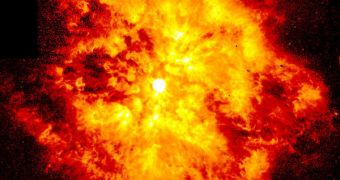Regularly, when Earth-based telescopes surveying the skies take notice of a supernova explosion somewhere in the Universe, they record a tiny flash of light, which then shortly disappears, as the remnants of the star spread away from its core. The Nearby Supernova Factory survey, at the Palomar Observatory in California, detected in April 2007 such an explosion, but that followed a different pattern. Rather than fading back into obscurity, the light from this supernova event got more intense, until it became visible even to the human eye.
As this happened, astronomers started wondering how come this explosion could produce such massive amounts of energy. Approximately 77 days later, the incoming light reached its peak intensity, but the supernova continued to burn brightly even 200 days later. The spot on the sky where the explosion occurred finally became black after 555 days, in October 2008. This even lasted several tens of times longer than any previously recorded supernova flash, and researchers were puzzled as to why this happened. To further amplify the mystery, they also learned that the event shouldn't have happened in the first place.
In order for such a massive explosion to occur, the star that generated it should have been “impossibly massive.” The only explanation that astrophysicists could think of was that it belonged to the old Universe, a relic of a times long gone that was forgotten. A breakthrough was achieved when researchers started peering through 40-year-old journal entries, and discovered the concept of a “pair-instability” supernova. The more scientists at the Weizmann Institute of Science in Rehovot, Israel, compared the theory with observations of SN 2007bi, the weird event, the more they saw the resemblance.
The reason why nobody figured this out before was that pair-instability supernovae were only a theoretical supposition, with no actual observations on record. In massive stars, photons generated by the nuclear fusion of hydrogen push against the weight that heavy elements exert towards the core, preventing the star from collapsing on itself. When this balance is broken, the star implodes, creating a type II supernova. In the case of pair-instability supernovae, the massive stars need to be up to 200 times the mass of the Sun. Inside, the temperatures generated by nuclear fusion become so large, that photons begin to convert on their own in pairs of electrons, and their antimatter equivalent, positrons.
As this happens, the amount of photons counteracting the weight of the star decreases, until the balance is broken, and the core collapses, triggering an unbelievably massive explosion, such as the one produced by SN 2007bi, NewScientist reports.

 14 DAY TRIAL //
14 DAY TRIAL //